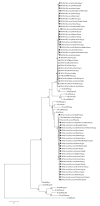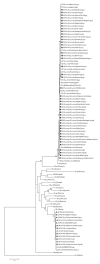Emergence of new recombinant noroviruses GII.p16-GII.4 and GII.p16-GII.2, France, winter 2016 to 2017
- PMID: 28449729
- PMCID: PMC5476982
- DOI: 10.2807/1560-7917.ES.2017.22.15.30508
Emergence of new recombinant noroviruses GII.p16-GII.4 and GII.p16-GII.2, France, winter 2016 to 2017
Abstract
An early increase in outbreaks of norovirus gastroenteritis characterised at the French National Reference Centre occurred this winter season. They were concurrent with an unusual pattern of circulating strains, with three predominant genotypes: the re-emergent variant GII.P4 2009-GII.4 2012 found in 28% of norovirus outbreaks and two new emergent recombinant strains GII.P16-GII.4 2012 and GII.P16-GII.2 never before observed in France, found in 24% and 14% of norovirus outbreaks, respectively.
Keywords: Norovirus; co-circulation; emergence; gastroenteritis; recombinants.
This article is copyright of The Authors, 2017.
Conflict of interest statement
Figures




Similar articles
-
Increased Detection of Emergent Recombinant Norovirus GII.P16-GII.2 Strains in Young Adults, Hong Kong, China, 2016-2017.Emerg Infect Dis. 2017 Nov;23(11):1852-1855. doi: 10.3201/eid2311.170561. Emerg Infect Dis. 2017. PMID: 29048294 Free PMC article.
-
Temporal evolutionary analysis of re-emerging recombinant GII.P16_GII.2 norovirus with acute gastroenteritis in patients from Hubei Province of China, 2017.Virus Res. 2018 Apr 2;249:99-109. doi: 10.1016/j.virusres.2018.03.016. Epub 2018 Mar 28. Virus Res. 2018. PMID: 29604360
-
Emergence of a Novel Recombinant Norovirus GII.P16-GII.12 Strain Causing Gastroenteritis, Alberta, Canada.Emerg Infect Dis. 2019 Aug;25(8):1556-1559. doi: 10.3201/eid2508.190059. Emerg Infect Dis. 2019. PMID: 31310222 Free PMC article.
-
Global and regional circulation trends of norovirus genotypes and recombinants, 1995-2019: A comprehensive review of sequences from public databases.Rev Med Virol. 2022 Sep;32(5):e2354. doi: 10.1002/rmv.2354. Epub 2022 Apr 28. Rev Med Virol. 2022. PMID: 35481689 Free PMC article. Review.
-
The epidemiology of norovirus gastroenteritis in China: disease burden and distribution of genotypes.Front Med. 2020 Feb;14(1):1-7. doi: 10.1007/s11684-019-0733-5. Epub 2019 Dec 10. Front Med. 2020. PMID: 31823287 Free PMC article. Review.
Cited by
-
Emergence of norovirus GII.P16-GII.2 strains in patients with acute gastroenteritis in Huzhou, China, 2016-2017.BMC Infect Dis. 2018 Jul 24;18(1):342. doi: 10.1186/s12879-018-3259-6. BMC Infect Dis. 2018. PMID: 30041612 Free PMC article.
-
Higher Viral Load of Emerging Norovirus GII.P16-GII.2 than Pandemic GII.4 and Epidemic GII.17, Hong Kong, China.Emerg Infect Dis. 2019 Jan;25(1):119-122. doi: 10.3201/eid2501.180395. Emerg Infect Dis. 2019. PMID: 30561298 Free PMC article.
-
Epidemiological characteristics and genetic diversity of norovirus infections among outpatient children with diarrhea under 5 years of age in Beijing, China, 2011-2018.Gut Pathog. 2021 Dec 24;13(1):77. doi: 10.1186/s13099-021-00473-x. Gut Pathog. 2021. PMID: 34952625 Free PMC article.
-
Norovirus Foodborne Outbreak Associated With the Consumption of Ice Pop, Southern Brazil, 2020.Food Environ Virol. 2021 Dec;13(4):553-559. doi: 10.1007/s12560-021-09495-9. Epub 2021 Aug 5. Food Environ Virol. 2021. PMID: 34351587
-
H and B Blood Antigens Are Essential for In Vitro Replication of GII.2 Human Norovirus.Open Forum Infect Dis. 2024 Dec 18;12(1):ofae714. doi: 10.1093/ofid/ofae714. eCollection 2025 Jan. Open Forum Infect Dis. 2024. PMID: 39758750 Free PMC article.
References
MeSH terms
LinkOut - more resources
Full Text Sources
Other Literature Sources
Medical
